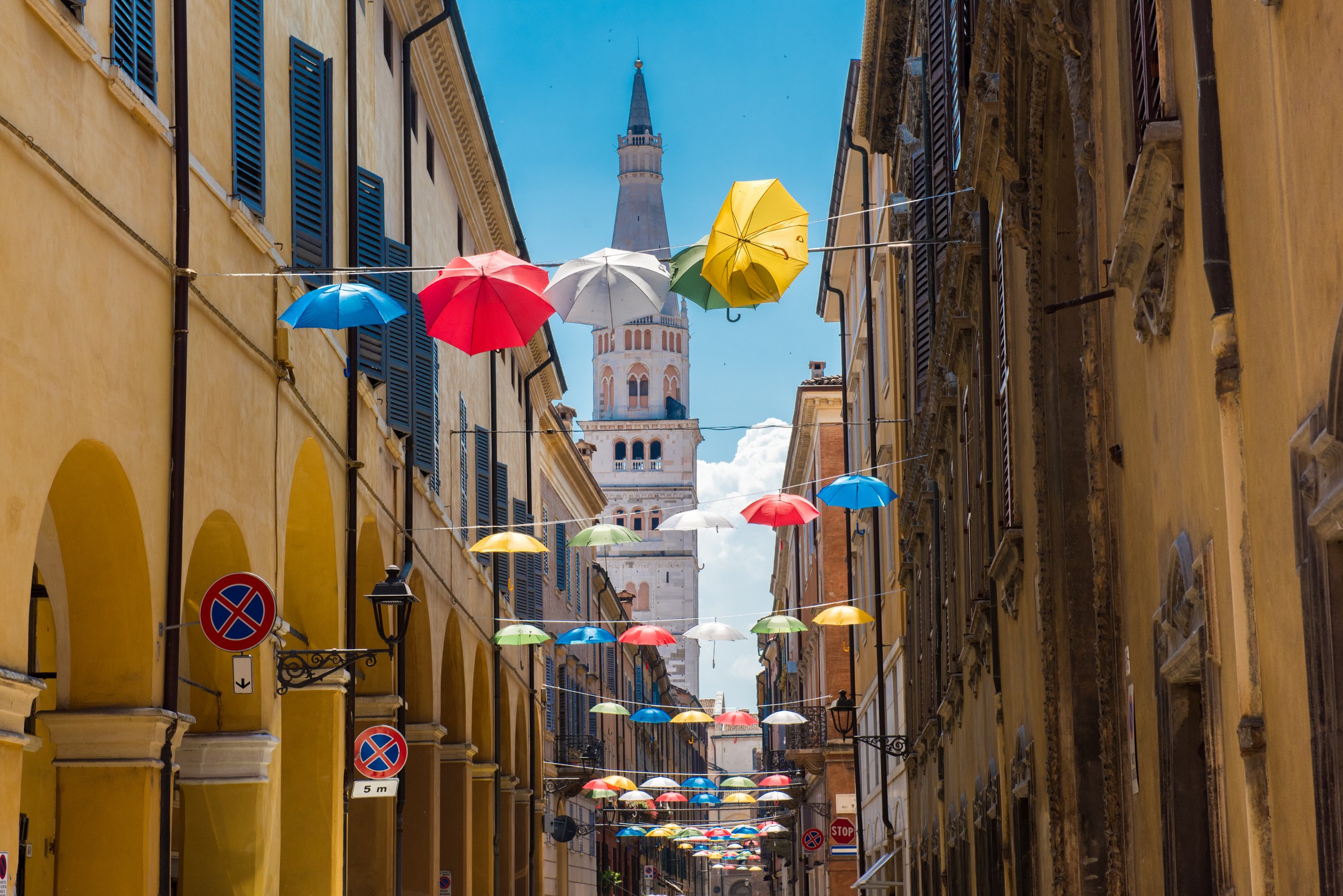Part 2 – Lambrusco in Modern Emilia-Romagna: Speed, Style & Sparkle
A Wine for Today
Lambrusco has a story stretching back to the Iron Age (check out part 1 ICYMI), but its legacy isn’t just in history—it’s in the glass today. Few wines in the world embody both heritage and modern versatility quite like Lambrusco. In Emilia-Romagna, it is the sparkling heartbeat of daily life: bold, effervescent, adaptable, and proudly tied to its land.
As the region has become a modern icon of craftsmanship—home to Ferrari, Lamborghini, Maserati, Pagani, Ducati, and artisanal food traditions—Lambrusco has kept pace. It has transformed from a rustic farmhouse table wine to a vibrant expression of style, versatility, and quality that resonates with contemporary wine lovers.
The historic city center of Modena today. Dating back to the Iron Age, Modena maintains its modern relevance through culinary excellence and cultural exports in the automotive world.
What Lambrusco Is Today
At its core, Lambrusco is not a single wine but a family of grape varieties native to Emilia-Romagna. The name “Lambrusco” refers both to the grape and the wine it produces, and it spans a broad spectrum:
Color: Most Lambrusco is a shimmering deep ruby red, but it can also be crafted into rosé styles that are equally refreshing and elegant.
Effervescence: Traditionally frizzante (lightly sparkling), Lambrusco’s bubbles are lively, adding freshness and energy. Today, producers also make it in spumante (fully sparkling) styles, comparable to Prosecco or Champagne in fizz.
Sweetness Levels: Lambrusco runs the gamut from secco (bone dry) to dolce (sweet), offering something for every palate.
This makes Lambrusco one of the most versatile wines in Italy.
A Wine of Many Styles
Lambrusco’s versatility makes it unique. It can be:
A Refreshing Aperitivo – Served chilled or even as a part of a Lambrusco Spritz, its effervescence makes it an ideal start to any meal.
A Food Wine – Few wines pair as well with food as Lambrusco. Its acidity and sparkle cut through rich flavors like Parmigiano Reggiano, Prosciutto di Parma, or hearty pasta dishes.
A Wine for Every Table – Lambrusco comfortably moves from casual trattorias to Michelin-starred restaurants, unlike wines reserved only for fine dining.
A Cocktail Ingredient – Bartenders now embrace Lambrusco for its ability to add color, fizz, and depth to cocktails. Imagine a Lambrusco spritz, or even replacing soda water in a Negroni Sbagliato with sparkling Lambrusco for a bold twist.
The Many Faces of Lambrusco: Key Varietals
Lambrusco is not one grape but many. Over 60 varieties exist, but a few have become the region's stars.
Lambrusco Salamino di Santa Croce – Named for its salami-shaped bunches, this variety offers a balance of fruitiness and structure, with bright cherry flavors and light tannins.
Lambrusco di Sorbara – Often considered the most elegant, Sorbara wines are lighter in color, tending toward garnet or even rosé, with fragrant floral and red berry notes. Perfect for those who enjoy a delicate, refreshing style.
Lambrusco Maestri – Known for its depth and darker fruit character, Maestri is often blended to add richness and body.
Lambrusco Grasparossa di Castelvetro – The boldest of them all. Grasparossa produces deeply colored wines with strong tannins and concentrated flavors. It is often called the “king of Lambrusco.”
Spotlight on Rosso Fosco – A Modern Icon
Among these varietals, Lambrusco Grasparossa di Castelvetro stands apart. It embodies everything that makes Lambrusco both ancient and modern:
Color & Character: Deep ruby with violet reflections, its intensity is unmistakable.
Flavor Profile: Rich dark fruit—blackberry, plum, black cherry—layered with subtle spice and earthy depth.
Structure: Thanks to the varietals like Grasparossa and it’s naturally thicker skins, this Lambrusco can show firmer tannins and more complexity than others.
Style: Most often produced in secco (dry) style, giving it sophistication and balance, but also in progressively sweeter versions for more elegance and even for dessert.
Fratelli del Vino’s Rosso Fosco is a modern expression of this tradition. Crafted in collaboration with Cantina Formigine Pedemontana, Rosso Fosco is an extra dry sparkling Lambrusco Grasparossa di Castelvetro DOC that captures the heart of Castelvetro. Its dryness and structure set it apart from sweeter, mass-market Lambruscos that gave the wine a poor reputation in the 1970s. Instead, it showcases Lambrusco’s true identity: bold, elegant, and perfectly suited to today’s wine culture.
Why Rosso Fosco Matters
Rosso Fosco is not just another bottle of Lambrusco—it represents a renaissance of authenticity.
For Food: Its dry, tannic backbone makes it the ideal companion to Emilia-Romagna’s iconic cuisine—rich lasagna, aged Parmigiano, or balsamic-drizzled meats.
For Wine Lovers: It appeals to modern drinkers seeking wines with character, freshness, and unmatched regional authenticity.
For the Future: It reclaims Lambrusco’s rightful place as a serious, crafted wine while keeping its joyful, approachable spirit.
In a world where wine often chases trends, Rosso Fosco stands as a reminder that authentic regional identity never goes out of style.
Conclusion: Speed, Style & Sparkle
Emilia-Romagna today is a region of energy and elegance. Just as Ferrari and Ducati reflect its drive for innovation and style, Lambrusco reflects its traditions, flavors, and joy. It is a wine that continues to evolve while staying rooted in place.
Lambrusco is no longer the simple farmhouse wine of centuries past—it is a modern expression of versatility and craftsmanship. And within that family, Rosso Fosco, made from Grasparossa, reigns as the king of Lambrusco, embodying the richness, sparkle, and authenticity that define both the wine and the region it calls home.
In part 3 we will explore Lambrusco’s deep ties to the culinary world.
